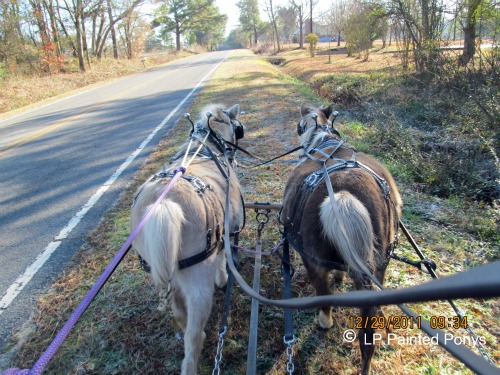I have not driven enough of our other ponies as pairs to deal with the "chargey" problem, though I expect it's pretty common. Part of it DOES come from, imho, competitiveness and/or hierarchy between the ponies.
I also have and will continue to work with ours singly - before working as pairs and also AFTER starting them as pairs - to teach commands that aid in getting them to work together better.
By that I mean, I preface a command w/ that ponies name, say the command and ask w/ the lines or the whip for the command to be executed. EX - "Bell, step up" OR "Bell, walk-on" - both meaning for just the pony named to stride out. At first, when the command is said the pony will/does ignore it - so I tap the hip with the whip - generally I tap the outside of the hip - if I know which side that pony is going to be on. When working single, I will tap the outside of the hip based on which direction we are working - I work in a lot of circles due to MY conditioning (can't walk straight out fast enough to keep up w/ pony w/o hanging on their mouths).
TRUST ME, your whip handling WILL IMPROVE, LOL!!!! Your hands and wrists will also get stronger - just from use. It does make a difference in whip weight and quality (a good quality whip is much lighter and easier to handle - I drool over them, but can't afford $80-200+ for a single whip that stays in my barn).
Same for slowing down - "Bell, EEEeee...ZZzz" or "Bell, sllloooowwwww"... then use the lines to bring about a slower pace. The pony DOES learn what each of these terms mean AND you can see my mares respond as soon as I say a name! BUT remember - I detailed much of our learning with Bell and Bit in 2010 and 2011 and we did a LOT of ground driving. The pics don't show nearly how much we did,

Then, when I pair the ponies together, I use "pair commands" or "group" commands as well as their individual commands. Since I started out with mares and still have mostly mares I generally say "OK, GIRLs, let's go" or "Girls, walk ON" to get started (and by GIRLS, they are taking their first stride!). When mixed sets - "PONIES, Whoooaaa" ... Or "Ponies, trot ON" (means to extend their trot & if Bell is part of that team, you'll see her head drop, her hind end drop and "dig" as she puts something like a 3-6" extension on her gait. When she first started trotting out, down the road she wanted to do that type of trot all the time and that's how we ended up dragging both Bit and Koalah who don't extend that way w/o a lot of schooling/work).
Now that the ponies have had more than a full year off from any type of work, we'll have to work on "rusty" command structure as well as body & wind conditioning. While a lot of it will have stayed, it's still going to be "rusty" - responses won't be as solid or as quick (and some will be "forgotten", LOL).
Since I still consider myself an amateur when it comes to training, I'd love to hear from some of the other folks who have trained pairs and larger groups, but I expect a number of those are busy right now with Nationals. Hopefully, over the winter?
And in that 2nd link up in post #3, I've found that I DO use a lot of voice commands - but I use them with single pleasure driving as well as it makes it easier for me to do things w/ my ponies. I DON"T talk to my ponies all the time, though sometimes I do sing! I also want them to be conditioned (somewhat) to me speaking/talking w/o talking to them as I sometimes take on passengers and I will speak to those folks and don't want the ponies responding to that...(part of the reason I learned early on to use a pony's name even when driving single).






























































